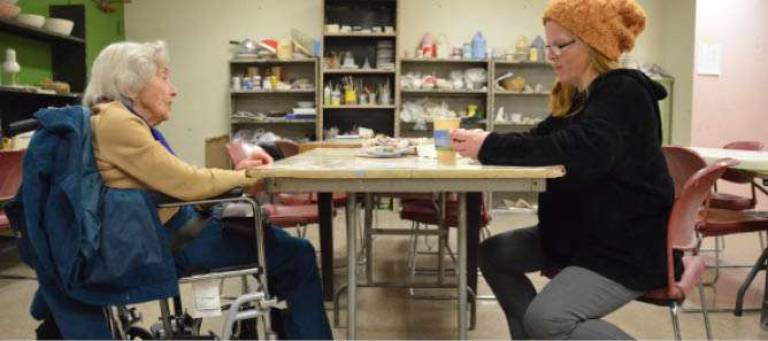Losing Sight, but Holding on to Memories

Seniors
A writing program, often in braille, for the visually impaired
During a recent class in a basement art studio at Visions at Selis Manor, a center for the visually impaired, playwright Barbara Cassidy asked her six writing students-all women-to make a list of items they would put in a memory box, and write a story based on one of the objects.
Some wrote of their mothers, childhood friends or family vacations. Others told of weekends at the roller rink, cheeseburgers and Cherry Cokes.
Elsie Smith, 51, remembered her mother's pearl necklace and typed her story on a braille typewriter.
"I like writing about memory, when I was growing up, my childhood," Smith said. Her mother passed away on Sept. 23, 1987: "I will always keep her. That's my special memory box: my heart."
Seniors Partnering with Artists Citywide-a program developed as part of the Age-Friendly NYC initiative and funded by the NYC Department for the Aging, in collaboration with the NYC Department of Cultural Affairs-places working artists in 50 senior centers throughout the five boroughs. The six-month course for seniors with visual impairments meets weekly for two hours, and culminates with a live play on June 6 at the Visions auditorium, with a script built from the personal stories crafted during the in-class writing exercises.
"It seems like a lot of their writing lends itself to monologue," said Cassidy. "They like to tell stories from their lives."
Cassidy first came to Visions about a year and half ago to lead a workshop through the NY Writer's Coalition. She applied to the SPARC program, which gives all artists in residence a $1,500 stipend and $500 in material reimbursements, in order to give her students at Visions another outlet for their writing.
"I had always been thinking in the back of my mind I would like to do some theater with them," said Cassidy, who earned her M.F.A in playwriting from Brooklyn College. "They're so ambitious?they want to go further with their work. This little workshop on Thursday wasn't enough for them. They asked, 'Where can we send our writing? Can we do a reading?' I said, 'I gotta get something more for these people.'"
Evelyn Larson, 81, whose service dog, a black Labrador named Idora, slept at her feet, also types in braille. She recalled her pink wedding dress, an Amethyst pin she won in her sixth-grade spelling bee, and a pair of snow pants she wore as a child. When they ripped, her mother mended the tear in the silky fabric, and Larson remembers running her fingertips along the stitches.
"I don't have much from my mother, but I still have those," Larson said. "I'd never give them up."
For Cassidy, working with visually impaired students brings a unique set of challenges. She collects their work each week, but she can't read braille and doesn't have any of Larson's work on her computer yet.
"I'm starting to panic about that," Cassidy said.
While Larson and Smith can read and type braille, other students in the class still have some vision and write their stories by hand using thin black markers. A few students lost their vision recently and haven't learned braille yet.
Edith Harnik was born in Austria and came to New York in 1942. Now 94, she's wheelchair-bound and losing her vision. She doesn't know braille and can no longer write, so she dictates to Cassidy, who pecks out the stories on her iPhone. Harnik recalled her first apartment, on the Upper East Side, and remembers her landlady, who showed her how to pack her dresses by rolling them instead of folding. When she got stuck and didn't know where to take her piece, she borrowed the theme of Goethe's poem, "The Sorcerer's Apprentice," for her a story about her childhood blanket named Ducky.
"I've never done anything like this," Harnik said. "It's new for me. Two hours of fantasy."
The structure of the play hasn't quite taken shape yet, Cassidy said, though the performance on June 6 will likely feature a mix of performers from her class and some outside actors. She's looking for a thread to emerge and connect the individual stories, but no matter the direction, she wants to avoid performing anything too "cutesy," which she thinks is a common impulse when working with seniors and the visually-impaired.
"When I first came to work with the visually-impaired, I had this kind of very naive, 'what does a blind person think?' stupid, uninformed attitude," Cassidy said. "This is a small part of who they are. They're all their own people and they all have different ideas and different ways of doing things. Just like there's not one way that they write. They're all writing in very different ways. It's a very complex thing. I think often we kind of make blind people childish in some way, in our thoughts about them, in our minds, and they're anything but."